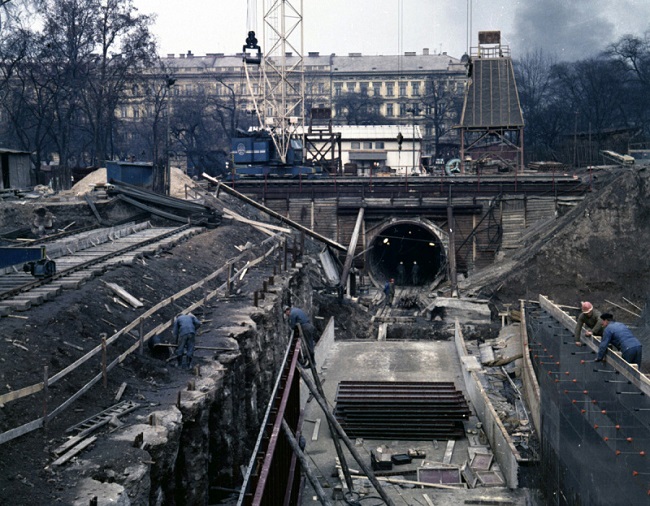
The Prague metro was originally constructed as a sub-surface tram
 |
Prague - Discussions about building an underground railway in Prague appeared as early as the end of the 19th century, with more concrete plans emerging towards the end of the First Republic, but actual construction only began at the end of the 1960s. The official start of construction is considered to be January 7, 1966, when a pneumatic hammer in the hands of worker Josef Bartoš was driven into the ground on Opletalova Street. At that time, however, the construction of the underground tram line was initiated, with the project only later evolving into a full metro system.
After 1960, Prague's public transport was no longer adequate to meet the needs of the growing city. Tram lines were overloaded, and for example, at Wenceslas Square, one train would alternate with another during the day. The government also addressed the issue, deciding in June 1965 to move trams underground in the city center, with plans for 14 kilometers of tunnels. "Modern T3-type trams will run in the tunnels, and the first section will lead from the lower level of the Nusle Bridge under Legerova Street in front of the Main Train Station," wrote Rudé právo as early as spring 1965.
The plans for the underground tram system had several advantages - such as direct connections to tracks leading to the periphery or the possibility of using modern T3 vehicles - but also many disadvantages. For instance, they required extensive demolition in the center and there were concerns about low capacity. "The proposed system... practically has no capacity reserve. The established maximum load current - in peak hours 12,600 passengers in one direction - will not be sufficient for Prague in the long term," stated a Soviet study from 1967.
By that time, work on the underground tram project had already begun, which the media presented as the dawn of a better era for public transport. "Construction of the underground tram has begun. Today at 2 PM, with a ceremonial groundbreaking in Opletalova Street, construction of underground routes for Prague's trams has started. Plans and projects are thus beginning to become a reality," celebrated Večerní Praha in January 1966. Ultimately, however, the concept of a full-fledged metro won out, with the government deciding on its construction in August 1967.
It also incorporated sections that had originally been developed for the underground tram - and their appearance is still evident today. The most notable example is the Main Train Station, which has been under construction since March 1967. However, the under-construction station was not redesigned, which is why the Main Train Station has an atypical side-platform arrangement for Prague's metro. The reason is simple: the underground tram vehicles were supposed to have doors on the right side just like conventional trams, whereas with the metro, passengers can disembark on both sides.
At the second similarly designed station on the first section of the metro - Vyšehrad, formerly Gottwald - the use of side platforms was due to its location on the edge of the bridge over the Nusle Valley. The second station, which began to take shape even before the change in course, Muzeum on the current Line C, also bears traces of the original plans. It is unusually spacious, as the designers proposed that Muzeum would have four tracks for two routes, with transfers taking place via an elevated level.
The change from underground tram to metro also significantly affected the most visibly external part of the first section of Prague's metro, the Nusle Bridge. The designers had originally calculated for the operation of relatively light tram vehicles - and even the light R1 vehicles developed for the metro in Prague's ČKD would not have posed a problem, but they did not advance beyond the prototype stage - however, the ultimately procured Soviet trains were substantially heavier. Therefore, a massive steel grid had to be installed in the already practically finished bridge.
The construction of the first section of the metro in Prague, which connected Kačerov with Sokolovská (now Florenc), took more than eight years. The last of the tunnels was completed in August 1972, but it took over a year before the first test vehicle ran on the tracks under Prague's streets - this happened on December 22, 1973, between Kačerov and Pražské povstání. At the end of December 1973, the first two-car train ventured into the tunnels. Testing began in early January, and in May 1974, the metro was opened to passengers.
The English translation is powered by AI tool. Switch to Czech to view the original text source.
0 comments
add comment
Related articles
0
20.04.2022 | The Prague metro has been operating since 1974, now it is 65.4 kilometers long and has 61 stations
0
22.07.2021 | Metro D has an invalid building permit. People from Pankrác have already appealed
0
05.01.2021 | Praha and DPP want to have a building permit for the construction of metro line D this year
0
03.08.2015 | Prague will announce an architectural competition for the stations of the new metro line D
0
15.09.2014 | Metro Line D will cost 60 billion, construction will start in 2017
0
19.01.2013 | The newly constructed route of metro line A was visited today by 17,500 people
0
18.06.2011 | Thousands of Prague residents came to see how the metro is being excavated
0
11.08.2008 | Thirty years ago, the Prague metro expanded with line A
0
24.05.2006 | Prague Metro in Numbers












